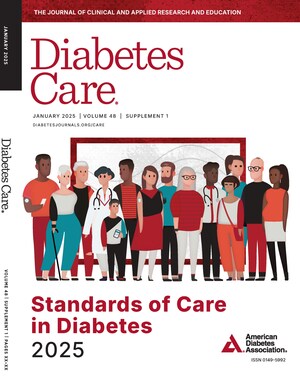SAN FRANCISCO, June 8, 2019 /PRNewswire/ -- Pancreatic beta cells that do not produce sufficient insulin in people with type 2 diabetes (T2D) are not permanently damaged during the early stages of the disease and can be restored to normal function through the removal of excess fat in the cells, according to a study entitled "Remission of Type 2 Diabetes for Two Years Is Associated with Full Recovery of Beta-Cell Functional Mass in the Diabetes Remission Clinical Trial (DiRECT)" presented today at the American Diabetes Association's® (ADA's) 79th Scientific Sessions®. More than one-third (36%) of the participants who took part in an intensive weight management program saw remission of their T2D after two years.
Type 2 diabetes is a progressive disease over time, and previous research has suggested beta cell death is the root cause of increasing failure of insulin-production and severity of T2D. Findings presented today examined beta cell production within a geographically-defined subgroup of the original DiRECT participants who had already achieved remission of T2D through diet-induced weight loss. The study found, however, beta cells are not permanently damaged in early T2D and can be rescued by removing the metabolic stress of excess fat within the cells. The findings are the result of the examination of insulin production on a subgroup at baseline (starting weight), immediately after weight loss (five months), and upon follow up of one and two years. Researchers defined participants as "in remission" if long-term blood glucose levels (HbA1c) were less than 48mmol/mol (6.5%) and their fasting glucose plasma (FPG) levels were less than 126mg/dl, without the use of any T2D medications.
The researchers used a Stepped Insulin Secretion Test with Arginine (SISTA) to quantify functional beta cell mass (maximum insulin secretory response during hyperglycemia). Insulin secretion rates were estimated by de-convolution, and participants' A1C and fasting plasma glucose (FPG) levels were assessed. Analysis determined that many from the group who had initially achieved remission of T2D – blood glucose levels capable of achieving non-diabetic blood glucose control although not considered normal – had remained in remission two years after the study. Within the 40 people who had initially achieved remission of T2D, 20 participants (13 male/seven female) remained in remission, 13 gained weight and relapsed, and seven did not maintain follow-up. Furthermore, when compared to a nondiabetic comparator (NDC) group used in the study, which matched the age/gender of the DiRECT intervention group participants after weight loss, the study participants' maximum rate of insulin secretion was comparable. The intervention group participants' insulin secretion increased from a median of 0.58 nmol/min/m2 at baseline to 0.94 nmol/min/m2 after two years, and the insulin secretion of the NDC group had a median insulin secretion rate of 1.02 nmol/min/m2 at 24-months follow up.
DiRECT is the latest in a series of studies to test the 2008 Twin Cycle hypothesis. Research released in 2011 reported a dramatic fall in liver fat and a significant decrease in intra-pancreatic fat levels following 33 pounds of weight loss with recovery of some beta cell function in people with T2D. In 2016, scientists reported that maintaining a healthy weight for nine months after a period of weight loss assisted in beta cell recovery. The open-labeled, cluster-randomized controlled trial involved 306 participants from 49 primary care practices in Scotland and England between 2014 and 2017. Patients ranged in ages from 20 to 65, had a body mass between 27-45 kg/m 2, were not receiving insulin and with up to six years duration of T2D. Practices were randomly selected to offer participants one of two treatments, both of which had already been shown to be effective. DiRECT aimed to ascertain which treatment option was more effective.
The control group was based on best-practice care guidelines from the National Institute for Health and Care Incidence (NICE) and the ADA's Standards of Medical Care in Diabetes (including antihyperglycemic and antihypertensive medications), while the intervention group became involved in a weight management program that included withdrawal of antihyperglycemic and anti-hypertensive drugs, total diet replacement (825-853 kcal/day for three to five months), structured food introduction and structured support for long-term weight loss maintenance.
"Our research explains the observed recovery from T2D. Equally as important, though, is the finding that recovery can be achieved through primary care as part of routine health care following current standards of care," said co-lead study investigator Roy Taylor, professor of medicine and metabolism at Newcastle University and Newcastle Hospitals NHS Trust. "People with type 2 diabetes have a choice rather than a life sentence. If the simple, effective method of weight loss and minimization of weight regain is undertaken, individuals with early type 2 diabetes can return to normal health with a profound decrease in risk of serious long-term complications associated with diabetes such as cardiac disease. Type 2 diabetes is a reversible condition, and remission can be achieved and sustained. Our research has also discovered a key message surrounding weight loss treatments. The current slow, steady approach is difficult and successful for only a few. In contrast, the approach of rapid, short-term weight loss followed by a long-term phase of avoidance of weight gain has been shown to be more productive."
To speak with Dr. Taylor, please contact the ADA Press Office on-site at the Moscone Convention Center on June 7-11, by phone at 415-978-3606 or by email at [email protected].
The American Diabetes Association's 79th Scientific Sessions, the world's largest scientific meeting focused on diabetes research, prevention and care, will be held June 7-11, 2019, at the Moscone Center in San Francisco, California. Nearly 15,000 leading physicians, scientists, health care professionals and industry representatives from around the world are expected to convene at the Scientific Sessions to unveil cutting-edge research, treatment recommendations and advances toward a cure for diabetes. During the five-day meeting, attendees will receive exclusive access to more than 850 presentations and 2,000 original research presentations, participate in provocative and engaging exchanges with leading diabetes experts, and can earn Continuing Medical Education (CME) or Continuing Education (CE) credits for educational sessions. The program is grouped into eight thematic areas: Acute and Chronic Complications; Behavioral Medicine, Clinical Nutrition, Education and Exercise; Clinical Diabetes/Therapeutics; Epidemiology/Genetics; Immunology/Transplantation; Insulin Action/Molecular Metabolism; Integrated Physiology/Obesity; and Islet Biology/Insulin Secretion. Gretchen Youssef, MS, RDN, CDE, President of Health Care and Education, will deliver her address, "It's All About Access!," on Saturday, June 8, and Louis H. Philipson, MD, PhD, FACP, President of Medicine and Science, will address attendees on Sunday, June 9. Join the Scientific Sessions conversation on social media using #ADA2019.
About the American Diabetes Association
Every day more than 4,000 people are newly diagnosed with diabetes in America. Nearly 115 million Americans have diabetes or prediabetes and are striving to manage their lives while living with the disease. The American Diabetes Association (ADA) is the nation's leading voluntary health organization fighting to bend the curve on the diabetes epidemic and help people living with diabetes thrive. For nearly 80 years the ADA has been driving discovery and research to treat, manage and prevent diabetes, while working relentlessly for a cure. We help people with diabetes thrive by fighting for their rights and developing programs, advocacy and education designed to improve their quality of life. Diabetes has brought us together. What we do next will make us Connected for Life. To learn more or to get involved, visit us at diabetes.org or call 1-800-DIABETES (1-800-342-2383). Information is available in English and Spanish. Join the fight with us on Facebook (American Diabetes Association), Twitter (@AmDiabetesAssn) and Instagram (@AmDiabetesAssn).
66-OR |
Remission of Type 2 Diabetes for Two Years Is Associated with Full Recovery of Beta-Cell Functional Mass in the Diabetes Remission Clinical Trial (DiRECT) |
79th Scientific Sessions
News Briefing: Reversal and Management of Type 2 Diabetes, Saturday, June 8, 8:45 AM PT
Session Type: Oral Presentations
Location: W-2001 (West, Level 2)
Session Time: Saturday, June 8, 2019, 8:00 am - 10:00 am
SVIATLANA V. ZHYZHNEUSKAYA, AHMAD AL-MRABEH, ALISON C. BARNES, BENJAMIN ARIBISALA, KIEREN G. HOLLINGSWORTH, HELEN PILKINGTON, NAVEED SATTAR, MICHAEL E. LEAN, ROY TAYLOR, Newcastle upon Tyne, United Kingdom, Lagos, Nigeria, Glasgow, United Kingdom
Aims: Observational studies have suggested that beta cell functional mass inevitably decreases over time. We assessed this after 2 years in a geographically defined subgroup of DiRECT who achieved initial remission after diet-induced weight loss.
Methods: A Stepped Insulin Secretion Test with Arginine (SISTA) was used to quantify functional beta cell mass (maximum insulin secretory response during hyperglycemia). Insulin secretion rates were estimated by de-convolution; 40 subjects initially achieved remission (HbA1c<6.5% and FPG <126mg/dl on no antidiabetic drug therapy). At 2 years 20 subjects (13M/7F) remained in remission, 13 gained weight and relapsed, and 7 lost to follow-up. A nondiabetic Comparator (NDC) group, matched for age/gender of DiRECT intervention group participants after weight loss, was studied.
Results: In the responder group, median (IQ range) maximum rate of insulin secretion increased from 0.58 (0.48 to 0.81) at baseline to 0.74 (0.54 to 1.00) at 5 months, 0.94 (0.57 to 1.24) (p=0.017 from baseline) at 12 months, and 0.94(0.64 to 1.44) (p=0.030 from baseline) nmol/min/m2 at 24 months. This was comparable to NDC (1.02(0.86 to 1.51) nmol/min/m2) by 12 (p=0.064) and 24 months (p=0.244).
Median first phase insulin response increased in responders from 0.042 (0.004 to 0.0637) at baseline to 0.108 (0.058 to 0.163) nmol/min/m2 (p<0.0001) at 5 months, to (0.110(0.059 to 0.201) then 0.125(0.066 to 0.166) nmol/min/m2; p<0.0001)] at 12 and 24 months.
Those who failed to maintain remission were characterized by more weight regain 5-24 months (11. 3±1.9 vs. 6.6±1.0 kg, p=0.036). In responders mean HBA1C was 6.0±0.0% at 24 months.
Conclusion: Provided weight regain is minimized, remission of type 2 diabetes is durable over 2 years, with a gradual increase to normal beta cell functional mass.
Author Disclosure Block: S.V. Zhyzhneuskaya: None. A. Al-Mrabeh: None. A.C. Barnes: None. B. Aribisala: None. K.G. Hollingsworth: None. H. Pilkington: None. N. Sattar: Advisory Panel; Self; Amgen Inc., AstraZeneca, Boehringer Ingelheim Pharmaceuticals, Inc., Novo Nordisk A/S. Consultant; Self; NAPP Pharmaceuticals Limited. Research Support; Self; Boehringer Ingelheim Pharmaceuticals, Inc. Speaker's Bureau; Self; Amgen Inc., Eli Lilly and Company, Mitsubishi Tanabe Pharma Corporation, Novo Nordisk A/S, Roche Diagnostics France, Sanofi. M.E. Lean: Consultant; Self; Counterweight Ltd., Novo Nordisk A/S. Research Support; Self; Novo Nordisk A/S. R. Taylor: Advisory Panel; Self; Wilmington Healthcare. Speaker's Bureau; Self; Lilly Diabetes, Novartis AG.
Contact: |
|||
Press Office in San Francisco |
Michelle Kirkwood |
||
June 7-11, 2019 |
(703) 299-2053 |
||
415-978-3606 |
SOURCE American Diabetes Association

Related Links
WANT YOUR COMPANY'S NEWS FEATURED ON PRNEWSWIRE.COM?
Newsrooms &
Influencers
Digital Media
Outlets
Journalists
Opted In






Share this article